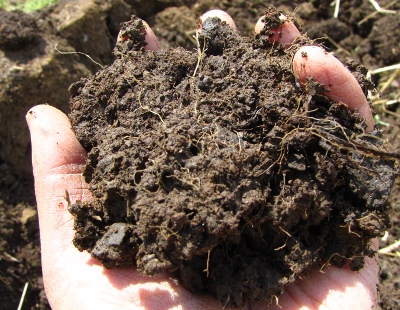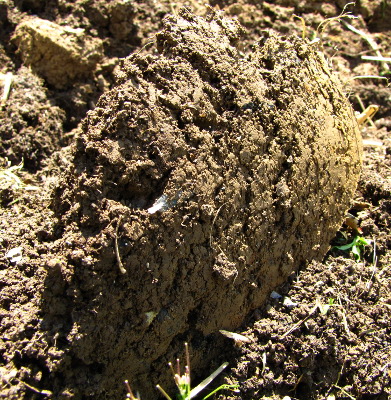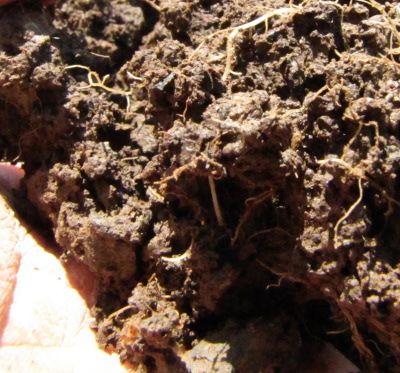
No-till soil structure
 If you grew up with
conventional gardening methods --- tilling up the soil every year ---
you might have a hard time wrapping your head around what happens in a
no-till garden over time. So I thought you would like to see a
bed that's been managed using no-till methods for the last five years.
If you grew up with
conventional gardening methods --- tilling up the soil every year ---
you might have a hard time wrapping your head around what happens in a
no-till garden over time. So I thought you would like to see a
bed that's been managed using no-till methods for the last five years.
I dug up this bed
Tuesday to enable me to plant my potatoes. We started the bed in
spring 2007, before I knew what a kill
mulch was, so initial soil preparation consisted of having Mark
till up the ground and then me shovel
the topsoil from the aisles to form raised beds. The bed
housed strawberries for a few years, then garlic (which necessitated
minimal digging for planting and harvest), then corn. Last fall,
I planted the bed in oats --- you can still see some oat roots not
quite deteriorated in the hunk of earth above.
 The
first thing to notice is that the soil is divided into horizons, just
like natural soil in a forest or meadow. (This photo shows a
shovelful of earth laying on its side, so envision it turned 90
degrees.) About six inches down, the B layer is mostly clay;
above that, the A layer is rich topsoil; and a thin coating of
partially decomposed organic matter (the O layer) sits on the top of
the ground. Since I don't disrupt their activity with tilling and
chemicals, there are plenty of worms in the earth to move organic
matter down into the A layer, which is why that topsoil is so dark,
rich, and crumbly.
The
first thing to notice is that the soil is divided into horizons, just
like natural soil in a forest or meadow. (This photo shows a
shovelful of earth laying on its side, so envision it turned 90
degrees.) About six inches down, the B layer is mostly clay;
above that, the A layer is rich topsoil; and a thin coating of
partially decomposed organic matter (the O layer) sits on the top of
the ground. Since I don't disrupt their activity with tilling and
chemicals, there are plenty of worms in the earth to move organic
matter down into the A layer, which is why that topsoil is so dark,
rich, and crumbly.
 No-till garden soil doesn't
have the same cake-crumb consistency you'll see in newly tilled earth,
but it also is far from compacted. (You can tell your soil is
compacted if it's hard to shovel.) When undisturbed, soil
microorganisms glue crumbs of earth into larger conglomerates, leaving
air pockets in between. When I break apart a hunk of my no-till
soil, it feels a lot like a bunch of
wood chips attached to each other by mycelium, tearing easily into
irregular chunks.
No-till garden soil doesn't
have the same cake-crumb consistency you'll see in newly tilled earth,
but it also is far from compacted. (You can tell your soil is
compacted if it's hard to shovel.) When undisturbed, soil
microorganisms glue crumbs of earth into larger conglomerates, leaving
air pockets in between. When I break apart a hunk of my no-till
soil, it feels a lot like a bunch of
wood chips attached to each other by mycelium, tearing easily into
irregular chunks.
Keep in mind that my
no-till garden consists of permanent garden beds that receive nearly no
traffic (except for an occasional dog footprint, but even Lucy is
pretty good about staying off them). The type of no-till farming
practices in conventional agriculture circles will likely lead to soil
compaction since they run heavy tractors across the earth and kill off
the worms with herbicides. In contrast,
no-till management in a backyard garden leads to rich, healthy soil
that grows great food.
Want more in-depth information? Browse through our books.
Or explore more posts by date or by subject.
About us: Anna Hess and Mark Hamilton spent over a decade living self-sufficiently in the mountains of Virginia before moving north to start over from scratch in the foothills of Ohio. They've experimented with permaculture, no-till gardening, trailersteading, home-based microbusinesses and much more, writing about their adventures in both blogs and books.
Want to be notified when new comments are posted on this page? Click on the RSS button after you add a comment to subscribe to the comment feed, or simply check the box beside "email replies to me" while writing your comment.

Sara --- We've got scads of clay and rain, but our soil doesn't seem to compact. I think that if you keep all traffic off the ground, you're far less likely to get compaction.
We use oilseed radishes to break up heavy soil. That's the more common name to look for when buying the radishes as cover crops, although you'll also hear them called tillage radishes and groundhog radishes. Daikon radish usually means the edible variety, I believe, which equates to more expensive seed.
One tip I learned last year was to cut big annuals like corn and okra off at the base rather than trying to rip the roots out. The root mass mostly decomposes by planting time next year, and even if it doesn't, you can just work around the stump. That's been a boon to my soil structure.